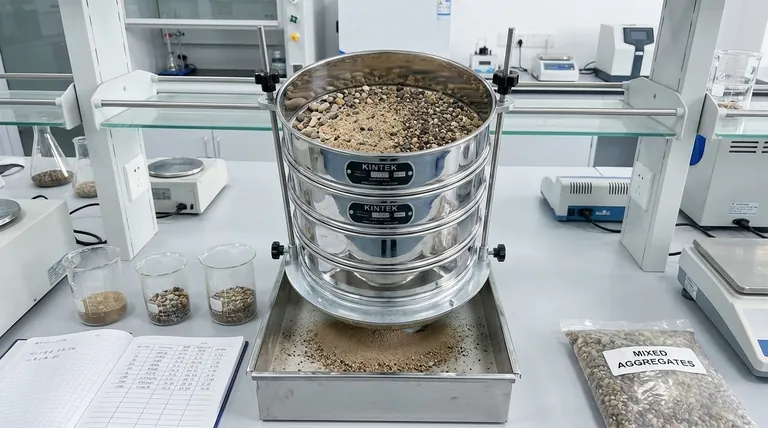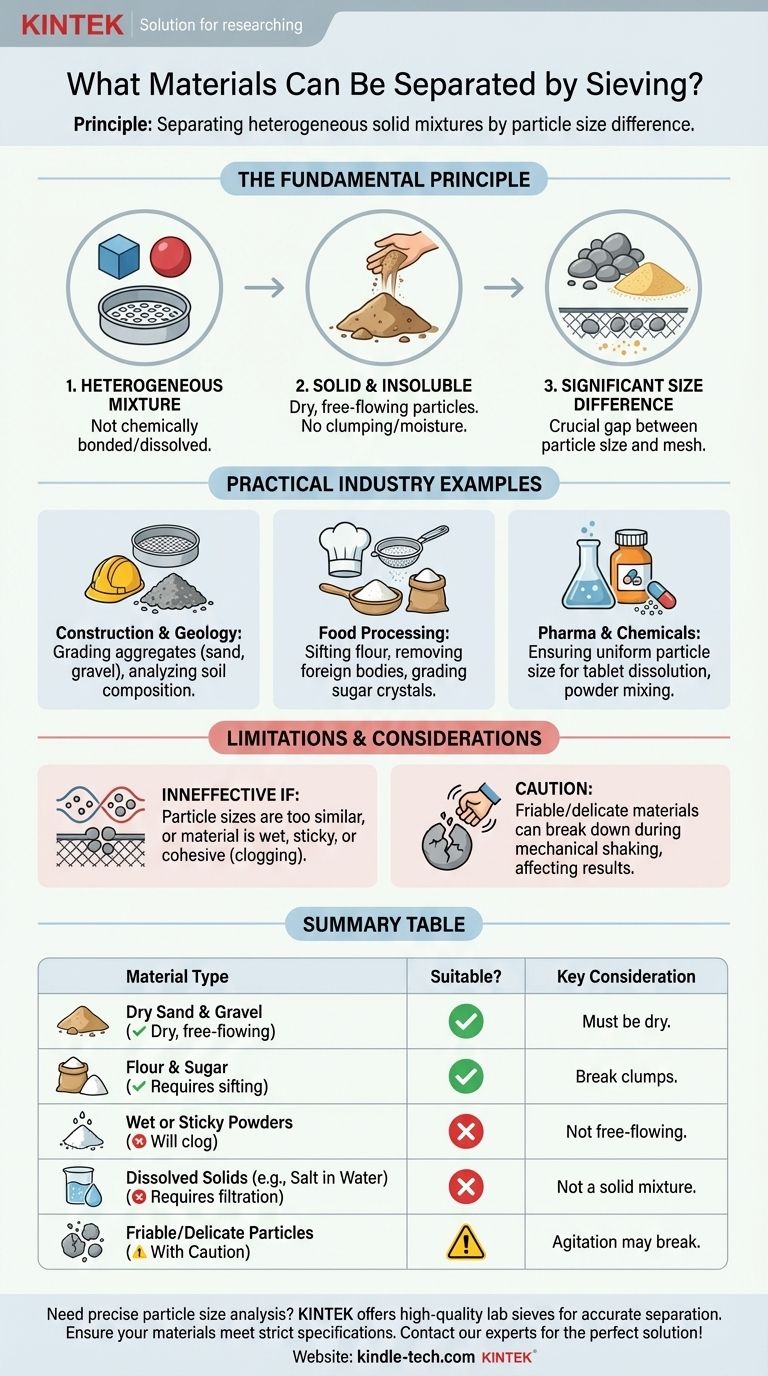In principle, sieving can separate any mixture composed of solid particles of different sizes. This technique is widely used for materials ranging from sand, soil, and gravel in construction to flour, sugar, and spices in the food industry, as well as powders and granules in chemical and pharmaceutical manufacturing.
The suitability of a material for sieving is not determined by its chemical identity, but by its physical properties. The method works only on heterogeneous mixtures of solid particles where there is a meaningful difference in size between the components.

The Fundamental Principle of Sieving
Sieving is a mechanical sorting process. Its success hinges entirely on the physical characteristics of the mixture you are trying to separate.
It Must Be a Heterogeneous Mixture
Sieving works by physically blocking larger particles while allowing smaller ones to pass through. This is only possible if the components are not chemically bonded or dissolved into one another.
For example, you can separate sand from gravel because they are two distinct components mixed together. You cannot, however, separate salt that has been dissolved in water using a sieve.
Components Must Be Solid and Insoluble
The method is designed for dry, solid particles. The components should not stick together, dissolve, or react with each other.
Materials must be free-flowing to move across the sieve mesh. Any moisture or stickiness will cause particles to clump together, preventing an effective separation and potentially clogging the sieve.
A Significant Size Difference is Crucial
The effectiveness of sieving is directly related to the difference in particle size between the components and the mesh size of the sieve.
If you are separating fine sand from large pebbles, a sieve with an intermediate mesh size will work perfectly. If you are trying to separate two types of powder with very similar particle sizes, sieving will be ineffective.
Practical Examples Across Industries
The principle of sieving is applied in nearly every industry that handles solid materials.
Construction and Geology
This is the classic application. Sieving is used to analyze soil composition and to grade aggregates like sand, gravel, and crushed rock for use in concrete and asphalt. A stack of sieves with progressively smaller mesh sizes can determine the particle size distribution of a sample.
Food Processing
In baking, flour is sifted to break up clumps and remove any foreign bodies, ensuring a uniform texture. In large-scale production, sieves separate different-sized grains, remove husks from seeds, or grade sugar crystals.
Pharmaceuticals and Chemicals
Uniform particle size is critical for many chemical products and medicines. Sieving ensures that powders or granules meet strict specifications, which affects everything from how quickly a tablet dissolves to how evenly a chemical powder mixes.
Understanding the Limitations
Sieving is a powerful but specific tool. It is the wrong choice for many separation tasks.
When Particle Sizes are Too Similar
If the components of your mixture have overlapping size ranges, a sieve cannot reliably separate them. Many particles of both types will either be retained or pass through together.
The Problem with Moisture and Stickiness
Wet sand, clumpy flour, or oily powders are poor candidates for sieving. The material will not flow properly and will blind the sieve mesh, halting the separation process entirely. The material must be dry and non-cohesive.
Delicate or Friable Materials
The mechanical shaking involved in sieving can break down fragile particles. If your goal is to analyze the original particle size, this agitation can damage the sample and give you inaccurate results.
Making the Right Choice for Your Application
To determine if sieving is the correct method, evaluate your material and your goal.
- If your primary focus is quality control for particle size: Sieving is the standard method for analyzing the size distribution of dry powders, aggregates, and granules.
- If your primary focus is bulk material purification: Sieving is highly effective for removing large contaminants from a finer product, such as stones from grain or clumps from a powder.
- If your mixture contains wet, sticky, or dissolved components: You must use a different method, such as filtration, evaporation, or centrifugation.
Ultimately, the success of sieving depends not on the material's name, but on its physical structure and the goal of your separation.
Summary Table:
| Material Type | Suitable for Sieving? | Key Consideration |
|---|---|---|
| Dry Sand & Gravel | Yes | Must be dry and free-flowing |
| Flour & Sugar | Yes | Requires sifting to break clumps |
| Wet or Sticky Powders | No | Will clog the sieve mesh |
| Dissolved Solids (e.g., Salt in Water) | No | Requires filtration or evaporation |
| Friable/Delicate Particles | With Caution | Agitation may break particles |
Need precise particle size analysis or reliable sieving equipment for your lab? KINTEK specializes in high-quality lab sieves and consumables designed for accurate separation of materials like aggregates, chemicals, and food products. Ensure your materials meet strict specifications—contact our experts today to find the perfect solution for your application!
Visual Guide

Related Products
- Laboratory Test Sieves and Sieving Machines
- Laboratory Vibratory Sieve Shaker Machine Slap Vibrating Sieve
- Laboratory Sterilizer Lab Autoclave Pulse Vacuum Lifting Sterilizer
- High Energy Planetary Ball Mill Machine for Laboratory Horizontal Tank Type
- Laboratory Sterilizer Lab Autoclave Vertical Pressure Steam Sterilizer for Liquid Crystal Display Automatic Type
People Also Ask
- What range of particle size does the sieve analysis apply? Master the 25 Micron to 1 mm Standard
- What are the steps in sieving method? A Guide to Accurate Particle Size Separation
- How long do I run my sieve shaker for? Find Your Material's Optimal Sieving Time
- What are advantages and disadvantages of sieving method? A Guide to Reliable & Cost-Effective Particle Sizing
- What are the apparatus used for sieve analysis? Build a Reliable Particle Sizing System



















